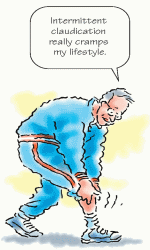Use this table to help you more accurately assess chest pain and its possible causes. |
What it feels like |
Where it’s located |
What makes it worse |
What causes it |
What makes it better |
Aching, squeezing, pressure, heaviness, burning pain; usually subsides within 10 minutes |
Substernal; may radiate to jaw, neck, arms, and back |
Eating, physical effort, smoking, cold weather, stress, anger, hunger, supine position |
Angina pectoris |
Rest, nitroglycerin (Note: Unstable angina appears even at rest) |
Tightness or pressure; burning, aching pain; possibly accompanied by shortness of breath, diaphoresis, weakness, anxiety, or nausea; sudden onset; lasts 30 minutes to 2 hours |
Typically across chest but may radiate to jaw, neck, arms, and back |
Exertion, anxiety |
Acute coronary syndromes which include acute myocardial infarction and unstable angina2 |
Opioid analgesics such as morphine, nitroglycerin |
Sharp and continuous pain; may be accompanied by friction rub; sudden onset |
Substernal; may radiate to neck and left arm |
Deep breathing, supine position |
Pericarditis |
Sitting up, leaning forward, anti-inflammatory drugs |
Excruciating, tearing pain; may be accompanied by blood pressure difference between right and left arm; sudden onset |
Retrosternal, upper abdominal, or epigastric; may radiate to back, neck, and shoulders |
Not applicable |
Dissecting aortic aneurysm |
Opioid analgesics, surgery |
Sudden, stabbing pain; may be accompanied by cyanosis, dyspnea, or cough with hemoptysis |
Anterior and posterior thorax |
Inspiration |
Pulmonary embolus |
Analgesics |
Sudden and severe pain; sometimes accompanied by dyspnea, increased pulse rate, decreased breath sounds, or deviated trachea |
Lateral thorax |
Normal respiration |
Pneumothorax |
Analgesics, chest tube insertion |
Dull, pressure-like, squeezing pain |
Substernal, epigastric areas |
Food, cold liquids, exercise |
Esophageal spasm |
Nitroglycerin, calcium channel blockers |
Sharp, severe pain |
Lower chest or upper abdomen |
Eating a heavy meal, bending, supine position |
Hiatal hernia |
Antacids, walking, semi-Fowler’s position |
Burning feeling after eating; sometimes accompanied by hematemesis or tarry stools; sudden onset that generally subsides within 15 to 20 minutes |
Epigastric area |
Lack of food, eating highly acidic foods |
Peptic ulcer |
Food, antacids |
Gripping, sharp pain; may be accompanied by nausea and vomiting |
Right epigastric or abdominal areas; may radiate to shoulders |
Eating fatty foods, supine position |
Cholecystitis |
Rest and analgesics, surgery |
Continuous or intermittent sharp pain; possibly tender to touch; gradual or sudden onset |
Anywhere in chest |
Movement, palpation |
Chest wall syndrome/costochondritis |
Time, analgesics, heat applications |
Dull or stabbing pain; usually accompanied by hyperventilation or breathlessness; sudden onset; can last less than a minute or as long as several days |
Anywhere in chest |
Increased respiratory rate, stress, anxiety |
Acute anxiety |
Slowing of respiratory rate, stress relief |
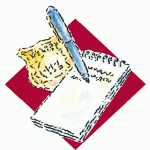 Just the facts
Just the facts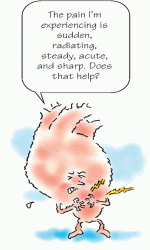
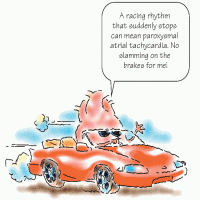
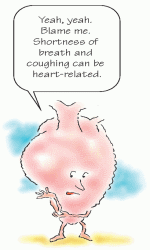
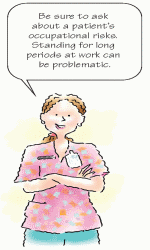
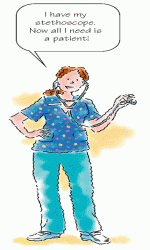
 Memory jogger
Memory jogger
